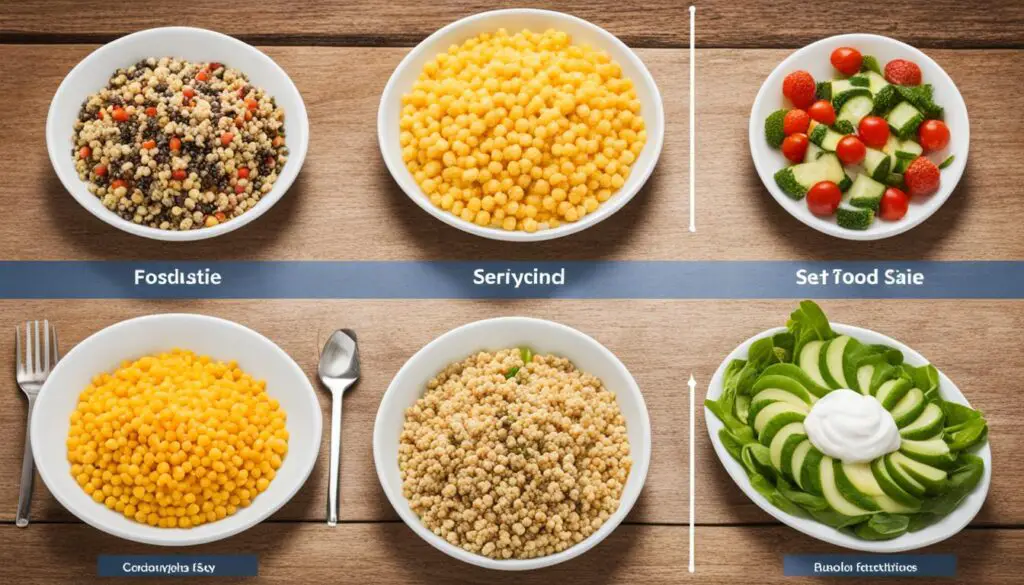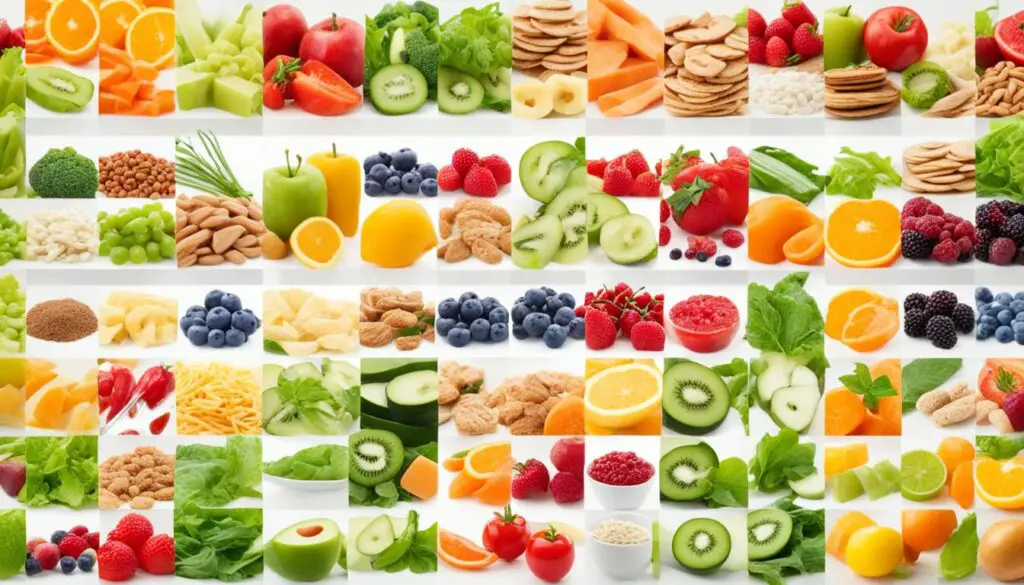It’s very important to know how to read food labels. This can help us make smarter choices when picking what to eat. The nutrition facts label tells us about serving sizes, calories, nutrients, and % daily value. We can use this information to pick foods that are better for our health.
By learning what’s on the label, like serving info, calories, and nutrients, we make wiser choices. We can also easily compare different products. This helps us see how our food choices affect our health. At first, it might seem like a lot of info to take in. But, with the right tips, reading labels will get much easier.
Key Takeaways:
- Reading food labels is essential for making informed choices.
- The nutrition facts label provides valuable information about serving sizes, calories, nutrients, and % daily value.
- Understanding different sections of the label helps in making healthier choices.
- Comparing products and understanding the impact of food choices on overall health.
- With label tips, decoding fitness labels becomes easy peasy!
How to Read and Understand Serving Sizes
The first step in understanding a nutrition label is serving sizes. They show us how much is in one serving. This helps us know what’s in our food and make better choices.
Keep in mind, the serving size might not match what we usually eat. Take chips, for instance. A serving might be just 1 ounce. But most people eat more in one sitting. So, being aware of how much we really eat is key.
Let’s use pizza to explain further. The label might say one slice is a serving. But say you eat the whole pizza. You’d have to adjust the nutrition facts to see what you’ve consumed.
| Serving Size | Calories | Fat (g) | Carbs (g) | Protein (g) |
|---|---|---|---|---|
| 1 Slice of Pizza (Serving Size) | 250 | 10 | 30 | 12 |
| Whole Pizza | 1500 (250 x 6) | 60 (10 x 6) | 180 (30 x 6) | 72 (12 x 6) |
The table clearly shows the effect of eating a whole pizza. Being aware of serving sizes lets us adjust for a more accurate view of our intake. This helps us eat in a healthier way.
Now, let’s look at calories in section 3. We’ll learn about their role and how they affect our energy levels.
Decoding Calories and Understanding Energy Content
Calories are key when talking about the nutritional value of food. They show how much energy a food can give us. This is important for our health.
Looking at the calories per serving on a nutrition label is crucial. It helps us see the energy we get with each portion.
Not all calories offer the same benefits. It’s not just about how many calories are in the food. We must also think about the nutrients they contain.
A good diet includes various nutrients, not just calories. Eating foods full of vitamins and minerals helps our body work best.
Knowing about calories aids in managing what we eat. It helps us pick foods that fit our health goals. This wisdom allows us to eat better and feel better.
| Nutrient | Calories per gram |
|---|---|
| Carbohydrates | 4 calories |
| Proteins | 4 calories |
| Fats | 9 calories |
| Alcohol | 7 calories |
Carbohydrates and Proteins:
Carbs and proteins give us 4 calories for each gram. They are key for energy and support our body’s needs every day.
Fats:
Fats give us 9 calories in every gram. Choose good fats from avocados, nuts, and seeds. Avoid unhealthy fats for better health.
Alcohol:
Alcohol doesn’t add nutrients but gives 7 calories for each gram. Be careful with how much you drink. Too much can lead to weight issues and health problems.
Knowing about food calories guides our choices. Remember, quality beats quantity. Choose nutritious foods to boost health and well-being, not just any food.
Deciphering Nutrients and % Daily Value
The nutrients section of a nutrition label tells us what’s in our food. Nutrients are the essential parts our bodies need. These parts include fats, carbohydrates, and proteins. Without them, our bodies wouldn’t work right. Vitamins and minerals are also key. They help us stay healthy and feel good.
Now, let’s talk about some key nutrients.
- Carbohydrates: Carbs give us energy for our daily tasks. We get them from foods like grains, fruits, and veggies.
- Proteins: Proteins help us build and fix tissues. They also keep our immune system strong. Find protein in meat, fish, beans, and milk.
- Fats: Fats are vital for hormone levels, keeping us warm, and vitamin absorption. Choose healthy fats from nuts, avocados, and olive oil.
Vitamins and minerals are vital too. They help our body work its best. Vitamins fall into two groups. Some can be stored, like A, D, E, and K. Others, like C and the B vitamins, we must eat every day. Minerals, such as calcium and iron, are also key for our health.
On food labels, you might see % daily value. This shows how much of a nutrient you need daily. It’s based on a 2000-calorie diet. If a food has, say, 20% calcium, it gives you 20% of what you need each day.
Comparing % daily values helps us pick healthier foods. If we want more calcium, we can choose foods higher in this nutrient. It’s a simple way to improve our diet.
“Understanding nutrients and % daily value helps us eat better. By checking food labels, we can make sure our meals are just right. This is how to get all we need for good health.”
Always check the nutrition label. This will help you plan healthy meals. A mix of nutrients keeps our bodies running well.
Conclusion
Understanding fitness labels is important for our health. By learning about nutrition labels, including serving sizes, calories, and nutrients, we can make smart food choices. It’s crucial to look at portion sizes and the nutrients in what we eat to stay healthy.
This knowledge lets us choose wisely when faced with many products. By reading labels, we know better what we’re eating. It makes shopping a way to better our health.
So, remember to check nutrition labels on your next shopping trip. Decoding these labels helps us pick foods that are good for us. Choose what fits your nutritional needs. Good health is a wonderful gift for your body and mind.
FAQ
Why is knowing how to read food labels important?
Knowing how to read food labels is key for making smart choices. We get info on serving sizes, calories, and nutrients. This helps us understand what we’re eating.
What is a serving size?
Serving sizes show how much of a product is one serving. Remember, what we eat in one sitting may differ. We should watch our portions using this info.
What should I pay attention to when reading calories on a nutrition label?
Focus on the calories per serving when you read a label. This tells you the energy you’re getting from the food. Also, note the nutrients you’re getting for those calories.
What information does the nutrients section of a nutrition label provide?
The nutrients part tells us about the food’s nutrients. It lists fats, carbs, proteins, vitamins, and minerals. The % daily value shows how much one serving offers.
How can I use nutrition labels to make healthier choices?
To pick healthier foods, learn how to read nutrition labels. Focus on serving sizes, calories, and nutrients. Keeping an eye on these details helps make better food choices.
Source Links
- https://www.superprof.ca/blog/understanding-food-labels/
- https://fitmencook.com/blog/how-read-food-nutrition-labels/
- https://www.bhf.org.uk/informationsupport/heart-matters-magazine/nutrition/sugar-salt-and-fat/10-tips-for-understanding-food-labels



